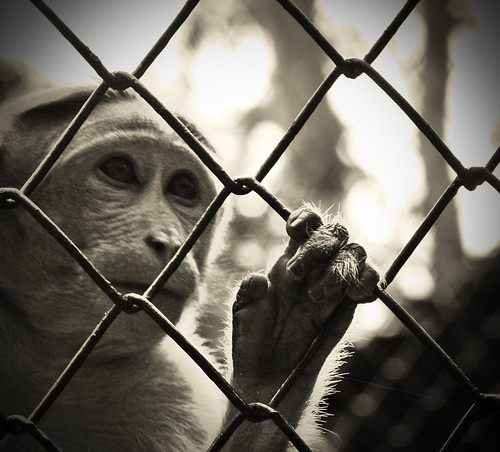When
ethologists, who study animal behaviour, looked into the weird
behaviours that are typical of many animals raised in captivity they
were puzzled. For example, they witnessed animals biting at
their own fur, feathers or hair or at those of other co-caged
animals. The range of animals who expressed this sort of thing
included parrots, sheep and mice to name but three. They were
puzzled because they could see no relationship to the weird behaviour
and the environment in which it took place. In short, the
behaviour could not be directly said to be related or caused by the
situation. It was from this puzzlement that the concept of
displacement behaviour emerged.
Three
mechanisms are believed to be responsible for these weird displacment
behaviours: (1) early environmental deprivation (2) the
disruption of habitat-dependent processes and (3) the thwarting of
behavioural response rules.
Firstly,
cases of environmental deprivation include animals reared in
isolation or away from maternal care. Secondly, the disruption
of habitat dependent processes may include not giving animals the
right kinds of foods or nesting materials so that behaviours
dependent upon these environmental aspects cannot be properly
expressed. Thirdly, animals in captivity are often physically
prevented from behaving in natural ways such as a cage that restricts
movement or which prevents it from achieving an ongoing goal.
The basic idea is that
when an animal is continually frustrated or where the environment
means that it cannot find an adaptive solution to an environmental
problem the brain wiring is disturbed and these odd behaviours come
to the surface. But why, for example, hair pulling and not a different
behaviour emerges is, as yet, unknown. However, the link between animals in
captivity showing this kind of a problem and people who pull out hair
seems one too big to overlook in my opinion.
If there is one thing I
would hope to get from this blog, it is that more and more people
consider these aspects when they seek to understand hair pulling.
References:
Akgul,
Y., Agaoglu, Z.T., Kaya, A., Sahin, T., (2000) The relationship
between the syndromes of wool eating and alopecia in Akkaraman and
Morkaraman sheep fed corn silage and blood changes (haematological,
biochemical and trace elements). Israel Journal of Veterinary
Medicine 56: 23-37.
Bordnick
P.S., Thyer B.A., Ritchie B.W., (1994) Feather picking disorder and
trichotillomania: an avian model of human psychopathology, J. Behav.
Ther. Exp. Psychiatry 25 (3) (1994), pp. 189–196.
Dias
R, Robbins T.W, Roberts A.C (1996) Disassociation in prefrontal
cortex of affective and attentional shifts. Nature
380: 69-72.
Kalueff,
A.V., Laporte, J.L., Bergner, C.L. (2010): Neurobiology of Grooming
Behaviour (Cambridge University Press)
Schrijver
N.C.A., Wűrbel, H.: (2001) Early social deprivation disrupts
attentional, but not affective, shifts in rats. Behav Neurosic 115:
437-42.
Wűrbel
H (2001): Ideal homes? Housing effects on rodent brains and
behaviour. Trends Neurosci 24:207-11.

No comments:
Post a Comment
Please leave your comment below: